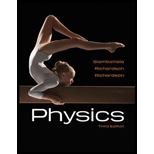
(a)
The magnitude of impedance of the circuit.
(a)
Answer to Problem 95P
The impedance of the circuit is
Explanation of Solution
Write the expression to calculate the impedance of the circuit.
Write the expression to calculate
Here, f is the frequency.
Rewrite the equation for Z using the above equation.
Conclusion:
Substitute
(b)
The magnitude of rms value of current.
(b)
Answer to Problem 95P
The rms value of current is
Explanation of Solution
Write the expression to calculate the rms current.
Here,
Conclusion:
Substitute
(c)
The magnitude of phase angle.
(c)
Answer to Problem 95P
The phase angle is
Explanation of Solution
Write the expression to calculate the phase angle.
Here,
Conclusion:
Substitute
Since the inductive reactance is less than capacitive reactance, the phase angle is negative. Thus, the phase angle is
(d)
Whether the current lead or lag the voltage.
(d)
Answer to Problem 95P
The rms value of current is
Explanation of Solution
Write the expression to calculate the ratio of capacitive reactance to the inductive reactance.
Here, r is the ratio.
Rewrite the above expression using the expression for
Substitute
Since the ratio is greater than 1, the value of capacitive reactance is greater than the inductive reactance. Thus, the current leads the voltage.
Conclusion:
(e)
The magnitude of rms voltages across the elements.
(e)
Answer to Problem 95P
The rms voltage across the resistor, inductor and capacitor is respectively
Explanation of Solution
Write the expression to calculate the voltage across the resistor.
Here,
Substitute
Write the expression to calculate the voltage across the inductor.
Here,
Rewrite the above equation using the expression for
Substitute
Write the expression to calculate the voltage across the capacitor.
Rewrite the above equation using the expression for
Here,
Substitute
Conclusion:
Therefore, the rms voltage across the resistor, inductor and capacitor is respectively
Want to see more full solutions like this?
Chapter 21 Solutions
Physics - With Connect Access
 College PhysicsPhysicsISBN:9781305952300Author:Raymond A. Serway, Chris VuillePublisher:Cengage Learning
College PhysicsPhysicsISBN:9781305952300Author:Raymond A. Serway, Chris VuillePublisher:Cengage Learning University Physics (14th Edition)PhysicsISBN:9780133969290Author:Hugh D. Young, Roger A. FreedmanPublisher:PEARSON
University Physics (14th Edition)PhysicsISBN:9780133969290Author:Hugh D. Young, Roger A. FreedmanPublisher:PEARSON Introduction To Quantum MechanicsPhysicsISBN:9781107189638Author:Griffiths, David J., Schroeter, Darrell F.Publisher:Cambridge University Press
Introduction To Quantum MechanicsPhysicsISBN:9781107189638Author:Griffiths, David J., Schroeter, Darrell F.Publisher:Cambridge University Press Physics for Scientists and EngineersPhysicsISBN:9781337553278Author:Raymond A. Serway, John W. JewettPublisher:Cengage Learning
Physics for Scientists and EngineersPhysicsISBN:9781337553278Author:Raymond A. Serway, John W. JewettPublisher:Cengage Learning Lecture- Tutorials for Introductory AstronomyPhysicsISBN:9780321820464Author:Edward E. Prather, Tim P. Slater, Jeff P. Adams, Gina BrissendenPublisher:Addison-Wesley
Lecture- Tutorials for Introductory AstronomyPhysicsISBN:9780321820464Author:Edward E. Prather, Tim P. Slater, Jeff P. Adams, Gina BrissendenPublisher:Addison-Wesley College Physics: A Strategic Approach (4th Editio...PhysicsISBN:9780134609034Author:Randall D. Knight (Professor Emeritus), Brian Jones, Stuart FieldPublisher:PEARSON
College Physics: A Strategic Approach (4th Editio...PhysicsISBN:9780134609034Author:Randall D. Knight (Professor Emeritus), Brian Jones, Stuart FieldPublisher:PEARSON





